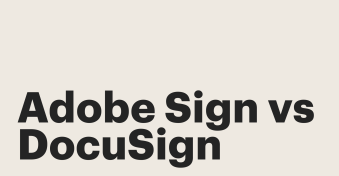Adobe’s Acrobat Sign is one of many e-signing solutions in today’s crowded market.
But is it the right platform for your business?
That can be a tough question to answer, especially because Acrobat Sign offers more than just e-signature tools. This platform also includes PDF editing, payment collection, and much more.
In this article, we’ll break down Acrobat Sign’s pricing plans and compare this platform to a few competitors to help you determine whether Acrobat Sign will suit your needs.
Let’s get started.
Key takeaways
- Acrobat Sign offers a broad selection of pricing plans for individuals, small businesses, and enterprise organizations.
- All Acrobat plans include PDF editing, one of Adobe’s key differentiators in the e-signing space.
- Acrobat Sign’s downsides include transaction limits, e-signature security that varies by plan, and limited integration options.
Features overview
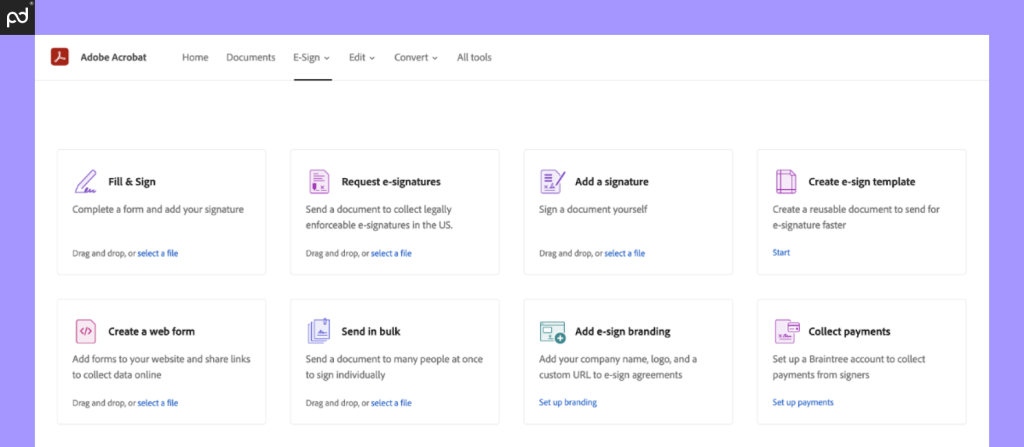
Acrobat Sign (full review here!) offers a unique solution in the e-signing marketplace.
Adobe developed and launched the PDF file format back in 1992 and has offered PDF editing and management tools (via Acrobat) since the late 80s.
In 2011, the company acquired EchoSign and used it as a launching point for the Adobe Sign platform.
The product offering has changed several times over the past 13 years. Here’s a current at Adobe’s key features for Acrobat Sign users.
| Baseline features | Advanced features |
|---|---|
| Collect electronic signatures | Document Cloud access |
| PDF editing tools | Payment collection |
| View & manipulate PDFs | Bulk sending |
| Notifications & audit trails | Branding |
| Mobile app | 24×7 product support |
| Form generation (limited) | CRM integrations & APIs |
| Template creation | Advanced authentications |
The basic features listed above are included in every plan, including the individual plans.
Many of the advanced features on our list require an upgrade to the top-tier individual plan (Acrobat Pro) mid-tier business solution (Acrobat Pro for teams) or the full enterprise plan (Acrobat Sign).
Features for every plan
In addition to helping users acquire digital signatures, Acrobat Sign includes a handful of standardized features that help to differentiate it from competitors.
PDF editing is the standout feature for most users on the Acrobat Sign platform.
Every e-signing plan includes access to Adobe Acrobat, which allows users to modify PDF files in ways that are beyond the scope of most other platforms.
Using Acrobat, users can edit text and images as part of the e-signing process, convert other file types to PDF, and much more.
When handling e-signing and signature requests, Acrobat Sign offers many features included on other platforms.
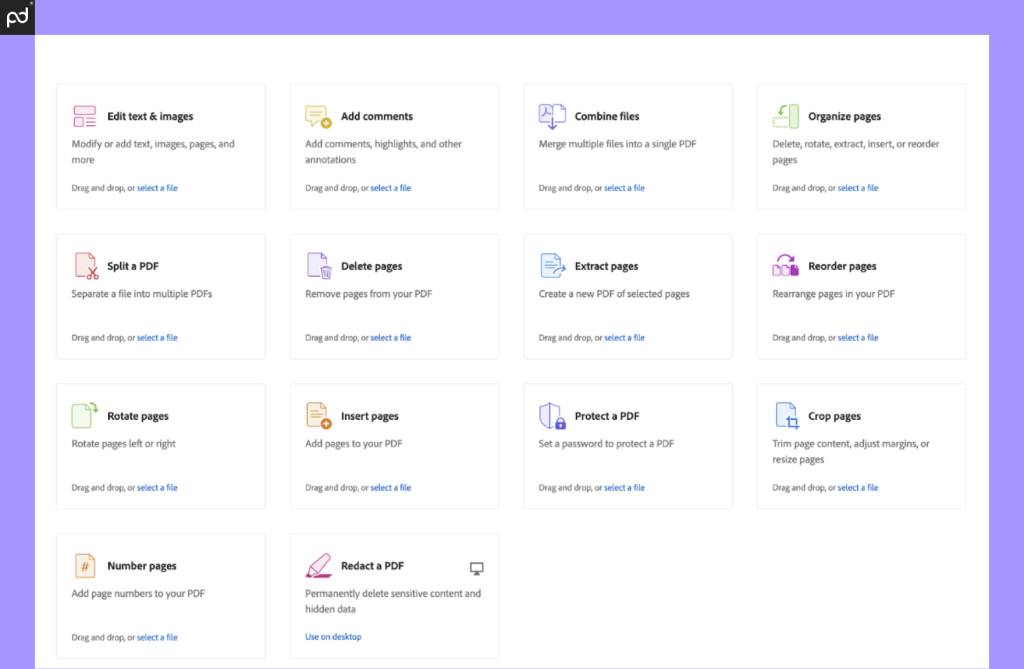
Users will be able to track documents, send notifications, and prepare forms.
Every plan, from individual to enterprise, also includes integration with Microsoft 365 apps (Microsoft Word, Excel, Powerpoint, etc.), to enable faster hand-offs between Adobe products and Microsoft’s productivity suite.
All of this is blended into a seamless workflow.
Users can edit documents, prepare documents for signature requests, then send documents to signers and track document progress.
Features for advanced plans
Moving away from the basic features, Acrobat Sign becomes more complicated.
This is, in part, because Adobe divides its plan selection in two ways: Acrobat Standard versus Acrobat Pro, and individual plans versus team plans.
Unfortunately, this is done simultaneously, so figuring out which feature belongs to what plan can be a challenge.
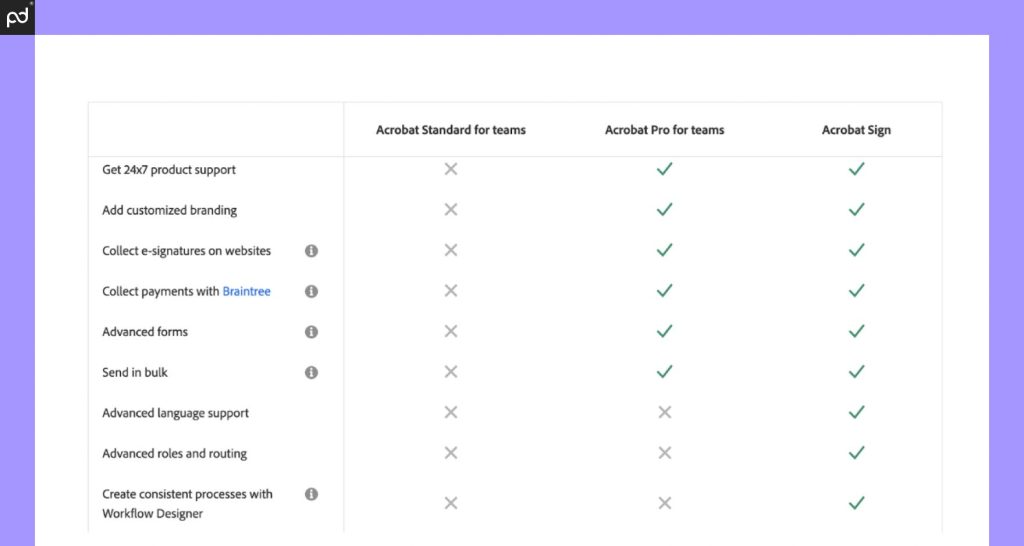
As a rule, sticking with the individual Acrobat Pro plan is the best option if you don’t need to manage users through the Admin Console.
While you will miss out on the 24×7 product support, you’ll gain access to Adobe Document Cloud, payment integrations, and bulk sending options, none of which are included in Standard for teams.
Transaction limits for the individual plans are also more relaxed.
We’ll drill down into the specific features of Acrobat Sign’s plans and pricing in the next section.
Plans for individuals
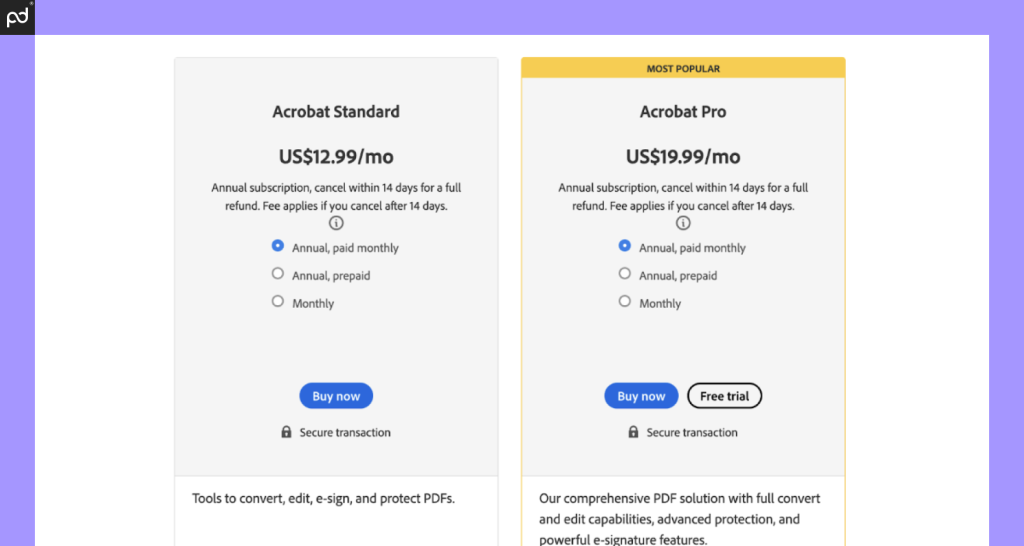
While Acrobat Sign’s standalone e-signing plans are marginally more cost effective than its team plans, the difference isn’t significant enough to matter.
Individual plans offer “unlimited transactions” while team plans are capped at 150 transactions per user/year.
While it’s still possible to be penalized for excessive overages, Adobe’s usage caps are more relaxed for these plans.
These plans are ideal for individuals and small businesses where one user will handle e-signing processes for the entire business.
Acrobat Standard
The most basic plan available, Acrobat Standard runs $12.99/month on an annual plan and is limited to one user.
This plan will provide all the tools users need to edit PDFs, collect digital signatures, and track document progress.
Users will also have access to Microsoft 365 integrations, and the ability to create reusable templates.
As far as entry-level plans go, this is a great offering from Adobe. DocuSign (compared below), offers a small collection of features but caps their entry-level plan to five sent documents per month.
Acrobat Standard users aren’t limited in such a way, allowing for greater flexibility and a much more relaxed e-signing experience.
Acrobat Pro
Key differences from previous tier:
- Custom branding options.
- Payment collection tools.
- Bulk sending options.
- Advanced form tools.
Slightly more advanced than Standard, Acrobat Pro runs $19.99 on an annual plan and is limited to one user.
This plan gives users the ability to add personalized branding to the digital signing experience and assign payment requests to outgoing documents.
Users also gain access to Adobe Document Cloud, the cloud-based sharing and storage platform for documents (not connected to Creative Cloud).
This functionality allows the use of browsers and mobile devices to review, edit, and share PDFs from anywhere.
Notably, users on the Pro plan will gain access to more powerful form creation tools, including the ability to place forms on websites for faster e-signature collection.
The negligible difference in cost makes this plan the ideal option for users who want to build complete document workflows with Acrobat Sign.
The next step up from this plan transitions users to Acrobat Sign business pricing, which is geared toward seat-based licensing toward larger organizations.
Plans for business
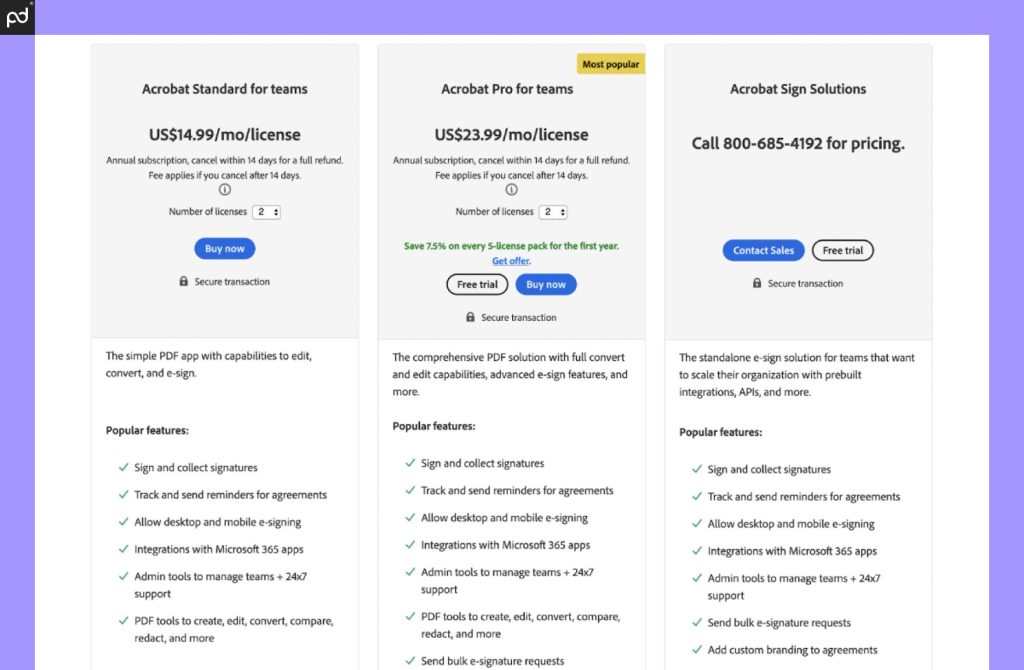
At this level, Adobe recalibrates its e-signing solutions for scalability and multi-user functionality.
All plans in this tier offer account management controls, an Admin Console, and delegation tools. In exchange, the feature set is more restrictive and lacks the flexibility of the individual plans.
Every team plan is only available via annual subscription and is capped at 150 transactions per user/year. The Adobe sales team can help high-volume senders secure higher transaction rates, however additional costs will apply.
Plans at this tier are targeted toward business teams and multi-user organizations who need to capture digital signatures as part of their document process.
Acrobat Standard for teams
Designed as the entry-level business plan, Acrobat Standard for Teams costs $14.99/month (annual) and is purchased by license.
In terms of features, this plan offers fewer perks than the individual Acrobat Pro plan, but it’s targeted toward a different set of users.
Standard for teams is the first plan which offers user and group management via the Admin Console. Administrators can also delegate accounts. Because this plan secures licenses, rather than individual users, it’s possible to reassign those licenses as needed.
Similar to Standard (individual), this plan offers PDF editing and e-signing tools and is a great starting point for teams who just need to automate their e-signing workflow.
However, keep in mind that every licensed plan has a transaction cap and usage should be calibrated accordingly.
Acrobat Pro for teams
Key differences from previous tier:
- 24×7 product support.
- Custom branding options.
- Payment collection tools.
- Bulk sending options.
- Advanced form tools.
Adobe’s mid-tier business plan, Acrobat Pro for teams costs $23.99/month (annual) and is purchased by license.
Similar to Acrobat Pro (individual), Pro for teams adds custom branding, payment collection, and bulk sending options alongside advanced form creation tools.
This plan is ideal for teams who want to create a more complete document process, particularly around proposals, contracts, and invoices where payment collection is a standard process.
Similar to Standard for teams, the major shortfall with this plan comes down to its lack of integrations.
While you’ll still have access to Microsoft 365 integrations, other options are locked behind the enterprise tier.
This is a greater issue with Pro for teams, because the plan features encourage broader usage without providing a means to connect to the rest of your tech stack.
One key feature of this plan is its around-the-clock product support (similar to what we offer at PandaDoc).
Users on Pro for teams can get in touch with the Adobe support team to troubleshoot and resolve issues quickly, allowing for improved uptime and technical assistance when required.
Acrobat Sign Solutions (enterprise)
Key differences from previous tier:
- Advanced authentication procedures.
- Improved security and compliance.
- CRM integrations.
- API access for embedded signing.
- No PDF editing functionality.
Adobe’s top-tier business plan, Acrobat Sign is only available via customized pricing and is purchased by license.
Of all the e-signing plans offered by Adobe, its enterprise solution may be the most confusing.
This plan adds advanced signing and security features, as well as CRM integration options with Salesforce, Workday, ServiceNow, and others.
Note that Acrobat Sign API pricing is determined separately.
Additionally, Acrobat Sign (enterprise) adds new security and compliance standards to improve security around digital signatures.
This includes compliance with HIPAA, FERPA, GLBA, and others.
However, Acrobat Sign (enterprise) removes the PDF editing functionality that is available on all other plans. At the enterprise level, these tools are only available as add-ons and must be included as part of the sales package created by an Adobe sales representative.
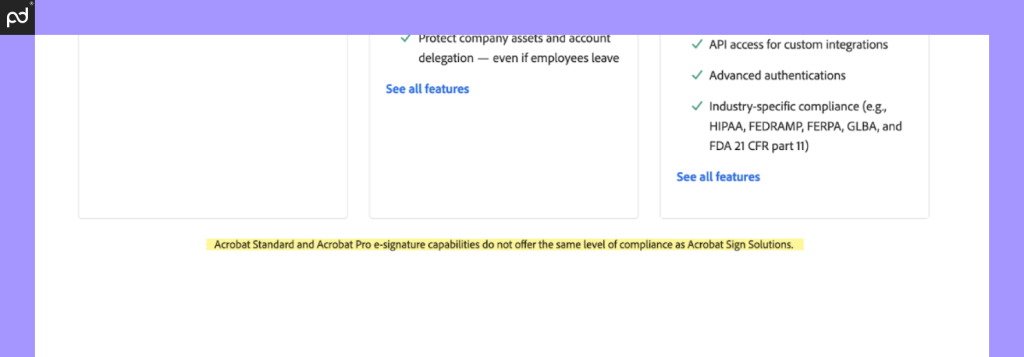
Users will still be able to sign documents and receive real-time notifications of document progress, but the ability to edit PDFs on the fly will incur additional fees.
For teams looking to do more with PDFs, Adobe’s choice to remove its editing tools from its enterprise software ultimately makes this solution less competitive when compared to other enterprise packages.
Acrobat Sign vs competitors
Now that we’ve covered Acrobat Sign’s features and plans, let’s take a closer look at how Adobe’s e-signing tools compare to other competitors in the marketplace.
DocuSign
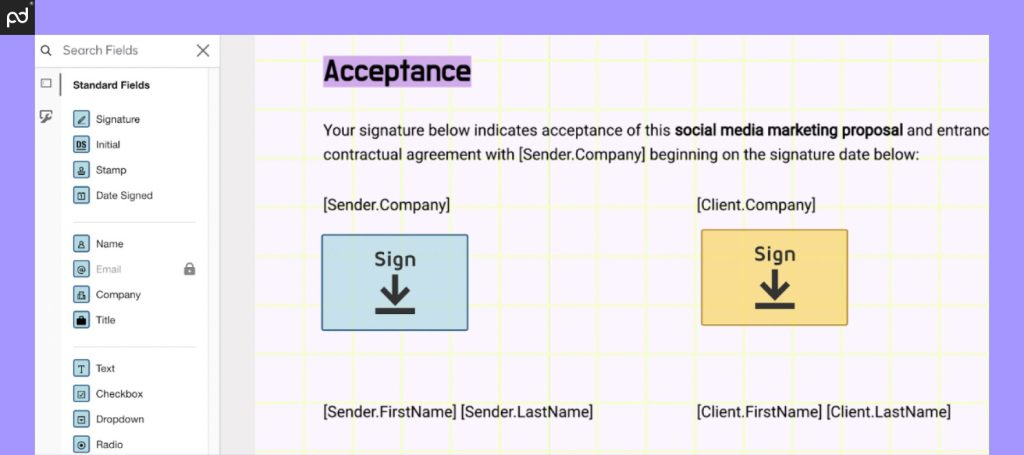
| Pros vs Acrobat Sign | Cons vs Acrobat Sign |
|---|---|
| + Easier to use. | – Plans are more expensive. |
| + Better integration options. | – No PDF editing. |
| + Improved security protocols. | – Lower transaction limit. |
Considered the industry leader in the e-signing space, DocuSign is notable for its user-friendly approach to e-signing, powerful integration options, and adherence to strict security standards.
All of these features ensure that the e-signing process remains quick and secure for both preparers and signers.
Past the interface, DocuSign offers hundreds of integration options, often connecting with niche software solutions, to further expedite the signature process.
While the integration solutions for popular CRMs and ERPs (Salesforce, Microsoft Dynamics, etc.) are locked behind enterprise plans, most of its 900+ integrations are available to every user.
Of course, all of these features come with a high cost.
When compared to Acrobat Sign, DocuSign is more expensive by a considerable margin.
It’s also far narrower in scope and usage, as it lacks any PDF editing capabilities and lower transaction limit (100 transactions/year; 10 transactions/month) for its user accounts.
PandaDoc
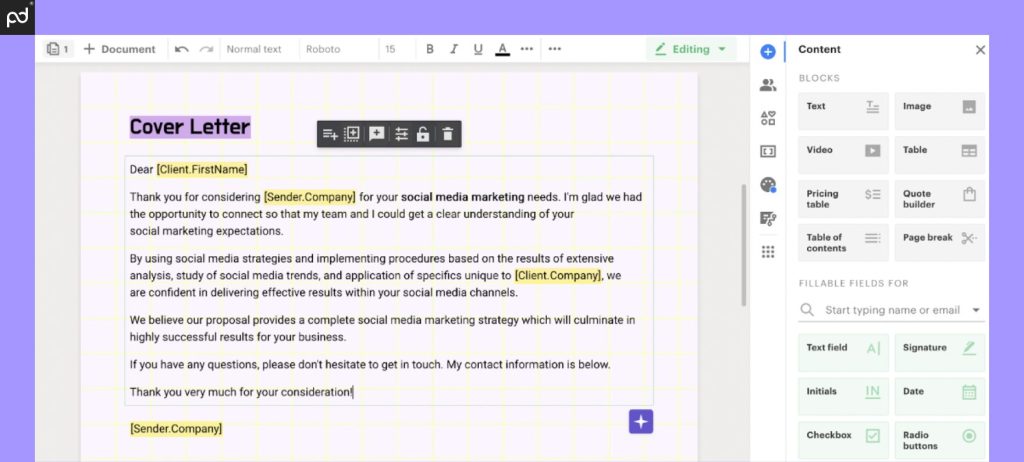
| Pros vs Acrobat Sign | Cons vs Acrobat Sign |
|---|---|
| + No transaction limits. | – Limited PDF editing tools. |
| + All-in-one document builder. | – Higher learning curve. |
| + Powerful template controls. |
PandaDoc is a strong alternative to Acrobat Sign that offers a different focus and workflow.
Despite its editing capabilities, Acrobat Sign is largely focused on e-signature capture.
While PDF editing can be very useful in the right situation, the intended use for this tool is still relatively minor. Any major document changes are best handled in the document’s original format (.docx; .xlsx; etc.).
This is where PandaDoc and Acrobat Sign diverge.
PandaDoc is designed to help users streamline their entire document workflow.
Our platform features an in-house document editor and broad set of tools designed to streamline all aspects of document creation.
Using our toolkit, it’s possible to create documents from scratch by adding text, tables, and rich media to a blank page — all in an editable format.
Teams can then create templates from existing documents and collaborate with signers to refine important details before capturing a digital signature.
It’s an all-in-one approach that streamlines your entire document lifecycle, from beginning to end.
Because of how our platform is intended to be used, we don’t have transaction limits like those seen in Acrobat Sign, DocuSign, and others.
Of course, PandaDoc isn’t for everyone.
Our platform has more to offer than other e-signing platforms, which makes it a poor fit for teams locked into a different document creation process or who are only looking for a dedicated e-signing tool.
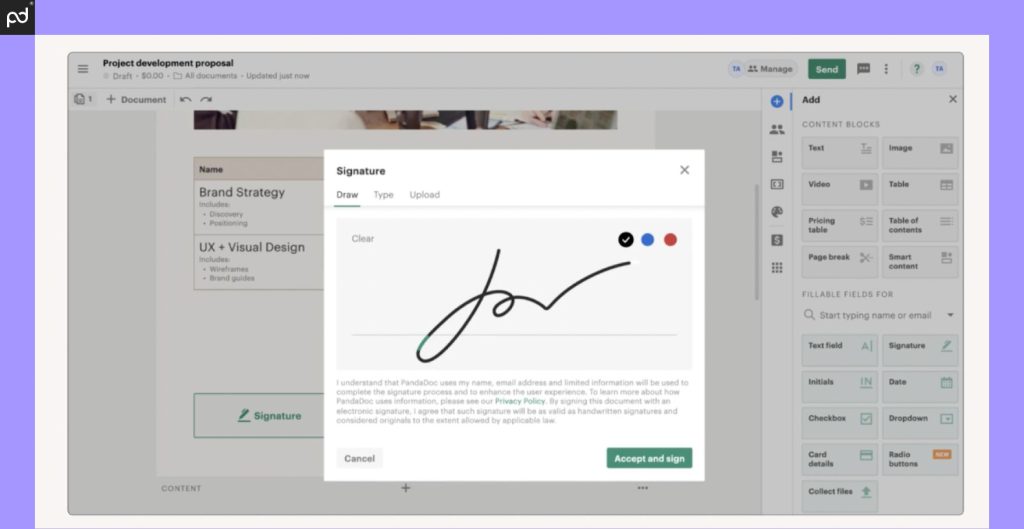
Dropbox Sign
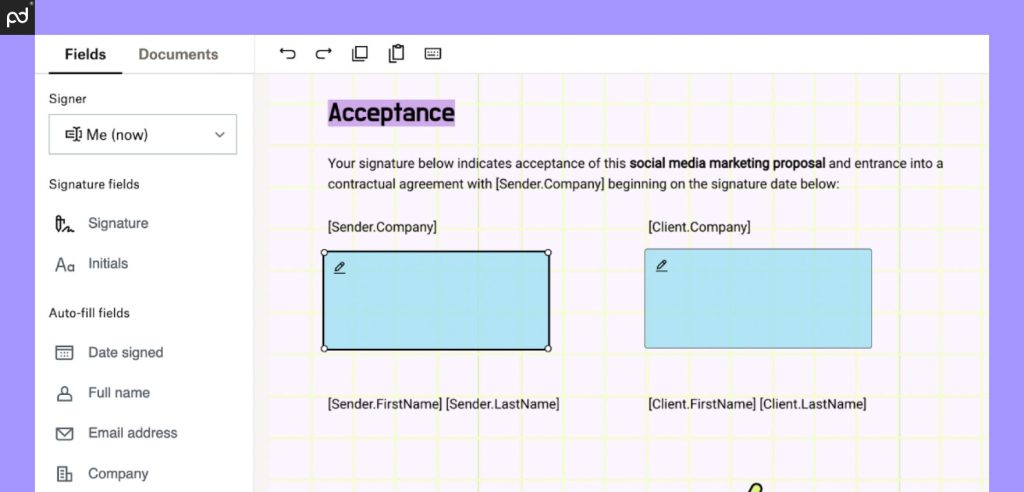
| Pros vs Acrobat Sign | Cons vs Acrobat Sign |
|---|---|
| + Easier to use. | – No PDF editing. |
| + No transaction limits. | – Minimum seat requirements. |
| + Native Dropbox integration. | – Limited template creation. |
Users who are just looking for an e-signing solution may find exactly what they need inside the Dropbox platform.
Dropbox Sign solution features a simple and intuitive interface, lower costs when compared to many competitors, and no transaction limits for sent documents.
Compared to Acrobat Sign, this platform comes with a few caveats.
While Dropbox Sign offers a few tools to assist with document preparation, it lacks the robust PDF editing capabilities found on the Adobe platform.
However, the biggest hurdle when using this platform comes down to Dropbox Sign’s seat requirements and confusing plan configurations.
Beyond the Essentials tier, Dropbox Sign mandates seat minimums on its plans.
The Standard plan requires two seats, and the Premium plan requires five seats.
If your team lacks the headcount or use case to utilize those tools, you’ll pay considerably more to access the features in those upper-tier plans.
While Dropbox Sign is seen as a separate product from Dropbox storage, the storage plans also offer some e-signing functionality.
Small businesses in need of both storage and e-signature tools may have some luck with those plans, as well.
SignRequest
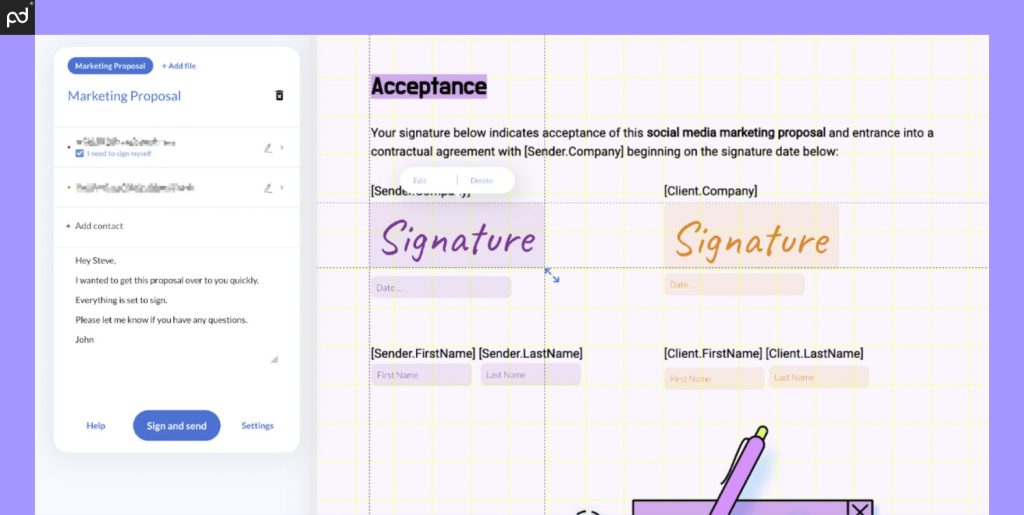
| Pros vs Acrobat Sign | Cons vs Acrobat Sign |
|---|---|
| + More affordable. | – Limited collaboration tools. |
| + Basic features available at lower tiers. | – Lacks PDF editing and form creation tools. |
| + Improved security protocols. | – No payment gateway. |
SignRequest is a budget-friendly alternative to most modern signing platforms.
It’s a great fit for users who need the core functionality found on platforms like DocuSign and Acrobat Sign but who don’t need extra bells and whistles like hundreds of integration options, PDF editing tools, or document storage.
Of course, that’s not to say that SignRequest has nothing to offer.
This platform is unique in that it offers all the necessary tools for streamlining the e-signature process.
Users can send documents to multiple signers, track document progress, and even integrate with productivity tools in their tech stack.
The interface is compact and simple to use, and the platform itself is compliant with modern security standards like ESIGN and eIDAS.
SignRequest’s appeal lies in its simplicity, but that comes with a few downsides.
Compared with platforms like Acrobat Sign and PandaDoc, this platform lacks the ability to modify documents or build complex workflows.
Additionally, its integration options mean that some functionality included in other platforms — like the ability to collect payments — isn’t available here.
Is Acrobat Sign best for e-signing?
While Acrobat Sign is definitely a powerful solution for digital signatures, whether it’s a “best fit” depends on your specific needs.
For users deeply embedded in the Adobe ecosystem, Acrobat Sign serves as a natural extension of already-familiar tools.
Access to Adobe’s Document Cloud is exclusive to the Adobe family of products, as well.
If you’re already using Adobe Reader or Acrobat, picking up a subscription with Acrobat Sign is a logical choice.
However, if you aren’t already connected to the Adobe document ecosystem in some way — or if you’re only using Adobe creative products — Acrobat Sign may not be the best fit.
While the platform’s PDF editing tools are practically unmatched, Acrobat Sign loses its appeal for teams who have no use for that functionality.
Editing functionality aside, Acrobat Sign lacks a key differentiator when compared to other narrowly scoped e-signing tools like Dropbox Sign or SignRequest.
This problem is notable at the enterprise level, where these features aren’t included in Acrobat Sign’s enterprise pricing.
Acrobat Sign also lacks the ability to build robust documents and create or improve the document lifecycle, so users who want to streamline these aspects of their workflow will need to look elsewhere.
Ultimately, the “best” solution will be the one that aligns with your unique needs and budget.
Alternatively:
Build better documents with PandaDoc
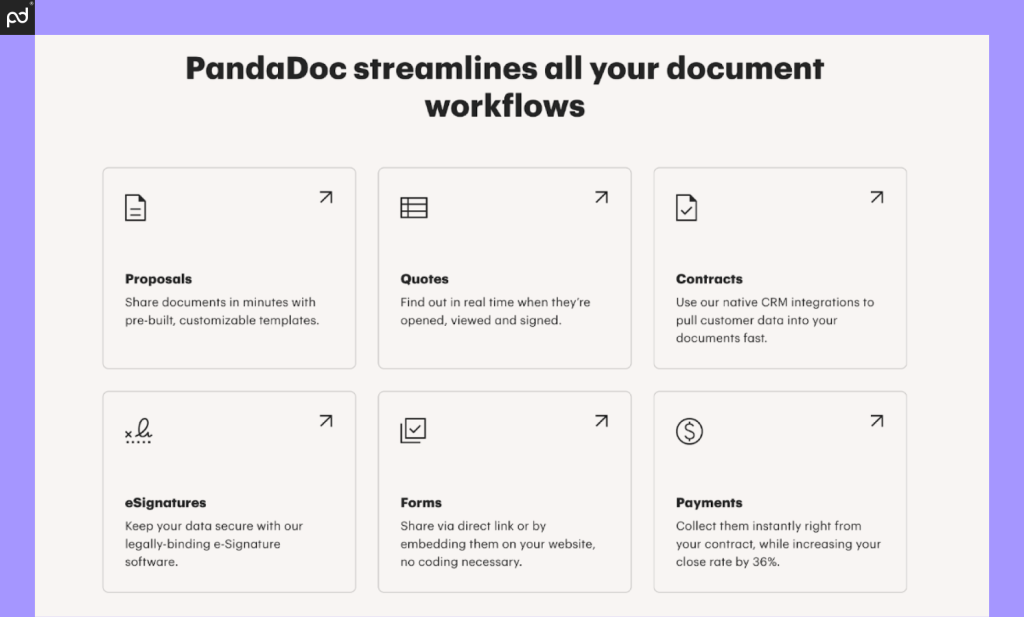
If you’re reviewing Acrobat Sign as a potential e-signing solution, we’d encourage you to take a few days and give PandaDoc a try.
We offer a comprehensive, all-in-one workflow designed to help teams create unique and personalized documents with ease.
Our built-in document editor allows users to upload Microsoft Word files and convert them into beautiful proposals and contracts.
You can also build documents entirely from scratch by modifying one of the templates in our vast template library.
PandaDoc has a solution for every aspect of document lifecycle management.
Build better documents, capture signatures with ease, set up contract renewals, create custom templates, and much more.
Sign up for a free demo or try our platform risk-free for 14 days!
Disclaimer
PandaDoc is not a law firm, or a substitute for an attorney or law firm. This page is not intended to and does not provide legal advice. Should you have legal questions on the validity of e-signatures or digital signatures and the enforceability thereof, please consult with an attorney or law firm. Use of PandaDoc services are governed by our Terms of Use and Privacy Policy.
Originally published January 4, 2021, updated August 30, 2024

